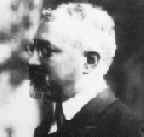Josep Puig i Cadafalch (1867-1956)

Works
In Barcelona:
–Amatller House
–Company House
–Macaya House
-Marti House (Els 4 gats)
-Muley-Afid House
-Muntades House
–Punxes House
-Sastre Marquès House
–Casaramona Factory
–Serra House
–Baró de Quadras Palace
-Pastor de Cruïlles Villa
In Argentona:
–Garí House
-Puig i Cadafalch House
In Canet de Mar:
-Restaurant del Santuari
-Fàbrica Carbonell Reverter
-Font Pública, Passeig Mare de Deu de la Misericòrdia / C. J. Mora
-Font Pública, Plaça Barris
-Font Pública del Parc del Santuari
-Primer Misteri de Dolor del Rosari Monumental del Santuari de la Misericòrdia
-Cinquè Misteri de Dolor del Rosari Monumental del Santuari de la Misericòrdia
-Placa del carrer Carles Pasqual i Puig
In La Garriga:
-Furriols House
In Lloret:
-Boundary cross
-Verge de Gracia shrine
-Costa Pantheon – Cemetery
In Mataró:
-City Hall
–Coll I Regàs House
-Parera House
-Sisternes House
-El Rengle
–La Beneficiència
In Sant Sadurní d’Anoia:
-Caves Codorniu
Life
Born in Mataró (El Maresme) near Barcelona in the year 1867.
Becoming a student, in 1887, he entered the “Centre Escolar Catalanista” and started to work in Matarò.
Later, he came to Barcelona, where he completed his architecture studies in 1891.
Named Professor of Architecture at the School of Architecture of Barcelona, he developed his great architectural capabilities.
In addition to his professional work as architect, he became active in politics, in the field of Catalan nationalism.
In 1917, when Enric Prat de la Riba died, he succeeded him as a Mancomunitat of Catalonia President (President of the Catalonian Government) developing an ambitious plan of schools and cultural institutions, organizing the Junta de Museus (Museum Association), new museums in Ciutadella Park of Barcelona, the improvement of the Empuries excavations, new roads and agricultural development of Catalonia.
A disciple of Lluís Domènech i Montaner, he is considered the last of representatives of Art Nouveau and the first of the Noucentisme (new artistic way following the Art Nouveau). His work can be divided into three different periods following the classification of Alexandre Cirici i Pellicer:
• The first, named the rose period (Art Nouveau), who’s model is the traditional aristocratic Catalan rural house (casa pairal) and also follows the inspiration of Germanic models. Buildings corresponding to the period are the Casa Martí (1896), the Macaya House, the Amatller House and specially the Casa de les Punxes or Terrades House(1905).
• The second, the white period (Rationalist idealism) follows the ideals of new burgess elite, pragmatic and strictly ordained. The buildings corresponding to this period are: Trinxet House (disappeared), the Muntades House and the Company House.
• The third period, the yellow period (Monumental)was developed during the 1929 Barcelona Universal Exhibition, for wich Josep Puig i Cadafalch was the first architect. This period is characterized by monumental buildings, the yellow colours of façades and the imitation of Romanesque architecture, which is melded with the typical architecture of Valencia and Andalusia giving a Baroque aspect as a result.
Very interested in North American architecture, he designed the Pich House wich was inspired by Sullivan.
Despite all of these activities, he also established a significant reputation as an historical art specialist, particularly on Romanesque medieval architecture. He wrote very important studies on historic architecture as “L’arquitectura romanica a Catalunya” (The Romanesque Architecture in Catalonia), “L’arquitectura gòtica civil a Catalunya” (The Gothic Civil Architecture in Catalonia) and many other books.
From 1942 until his dead in December 1956 in Barcelona, he was the President of the “Institut d’Estudis Catalans” (Catalan Studies Institute – The Catalan Language and Scientific Studies Academy -).
Specific Bibliography |
|||
| Title of book |
Author | Published by |
Year |
| Puig i Cadafalch | Bassegoda Nonell, J. | Edicions de Nou Art Thor | 1985 |
| Puig i Cadafalch, L’arquitectura entre la casa i la ciutat |
Different authors | Fund. La Caixa / Col.legi Arquitectes Barcelona Balears |
1989 |
| Puig i Cadafalch. Arquitecte, politic i historiador de l’art |
Jardi, E. | Ariel | 1975 |
Other Catalan Art Nouveau Architects
Antoni Gaudí i Cornet
Lluís Domènech i Montaner
Josep Puig i Cadafalch
Antoni Maria Gallissà i Soqué
Josep Maria Jujol i Gibert
Cèsar Martinell i Brunet
Manel Joaquim Raspall i Mallol
Joan Rubió i Bellver
Enric Sagnier i Villavecchia
Salvador Valeri i Pupurull
and others
